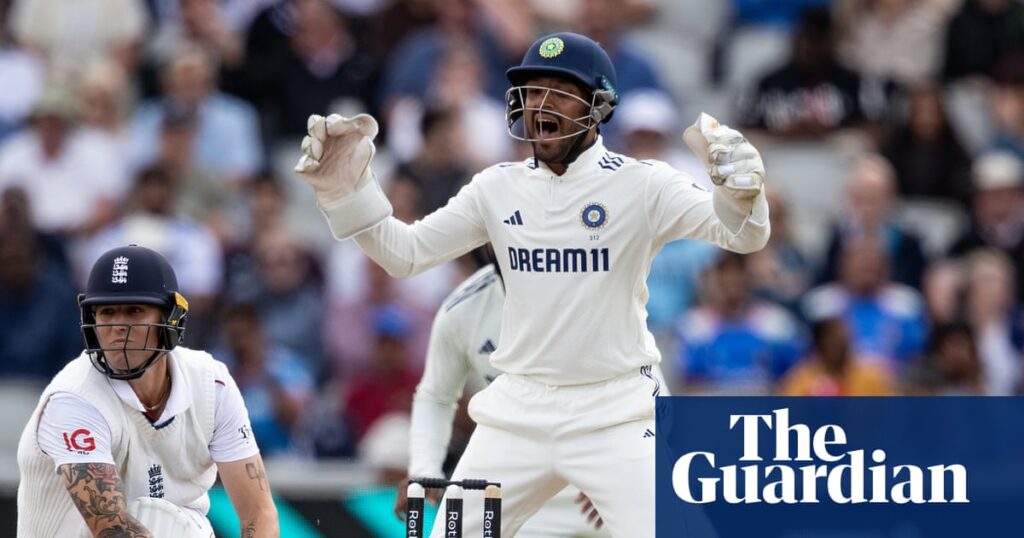I’ll be honest, I’m done in. Not feeling it. Quills deep in the red zone. This white blank page looks impossibly foreboding. I feel like I’m blinking up at a vast Eiger-shaped word document. Nine hundred words of Garamond from the summit and my crampons are made of blancmange.
You think these Spin columns are easy? I had four days in bed after the last one. I need to get out of this. I’ve been called up, but now it’s plain to see it’s not working. Should I claim Scrivener’s palsy? The yips? Desperately and repeatedly slam the laptop lid on my knuckles? Channel Allan Border to Dean Jones at Chennai in 1986? “Let’s get a proper cricket writer out here. A southerner.” Andy Bull. Tanya Aldred. Let’s be ’avin you!
But sometimes you have just got to get on with it. Deal with the situation you’re given. Ben Stokes has not made it easy to get on board with all of his words and deeds at the end of the drawn Old Trafford Test, but on the issue of cricketing substitutions, well, I’ll snatch his hand off. He described the prospect as “absolutely ridiculous” and that “there would be just too many loopholes”.
Injury replacements are due to be trialled by some boards at first-class level this year. Stokes – who will miss the final Test himself because of a shoulder injury – went on to state that the conversation should be “shut down and stopped”. England’s captain once again flying in the face of soft power and showing his interventionist tendencies.
Naturally, as befits the Test series, India’s coach, Gautam Gambhir, took the opposite view. With Rishabh Pant’s fractured foot no doubt fresh in his mind Gambhir said an injury replacement should be allowed in such a scenario.
Under the existing laws of the game, India’s reserve wicketkeeper Dhruv Jurel was allowed to replace Pant behind the stumps but not permitted to bat. Gambhir’s take is a surprising one. He is known for being tough and uncompromising as a player and a coach, instilling a Stakhanovite work ethic and training regime into his players and, as befits a man with such luxuriant Victorian sideburns, he seems to bristle at the merest whiff of weakness.
Gambhir seems to bristle at almost anything; he has the air of a bloke for whom the entire universe is a perceived slight. The guy has got resting-death-stare-face, appearing permanently close to putting up his dukes and offering people outside.
But on the issue of subs Gambhir has gone soft. Injuries are part of the game, they are bad luck and no one wants to see them, they can leave a side staring down the barrel of a significant disadvantage. James Anderson pulling up lame on the first morning of the 2019 Ashes left England a bowler short for almost the whole game. Nathan Lyon suffering a mid-game crooked calf at Lord’s four years later left Australia faced with the task of bowling England out without their premier spinner. (Reader, they managed it.)
As anyone who has played or watched cricket for any length of time knows, the game has a way of levelling things out. It is a lesson learned by all amateur cricketers – call it mother cricket, call it reverse-swings and roundabouts, call it a peculiar case of oscillating cricketing equilibrium. You get away with one this week, you will get a stinker the next. That is just the way it goes. The fine balance between success and failure is baked in, it is all part of cricket’s beguiling and maddening alchemy.
after newsletter promotion
It is not just Stokes and Gambhir that disagree on injury replacements, former players and pundits are split down the middle. The former England captain Michael Vaughan is in favour, decrying the current ruling as being akin to something from the dark ages. Steven Finn was firmly against, posting on X about the fine balance and arm wrestling nature of Test cricket: “The game is played over five days for a reason. (Some) teams bat long in order to wear a bowling unit down. If you could substitute a fresh bowler in because of injury it would just be wrong. How on earth do you determine what an injury is? MRI scanners at every ground to check a muscle tear?”
The cricketing world is increasingly one of hot takes and hypocrisy. Do we really want to go down the route of debating what constitutes an injury worthy of replacement, endlessly debating how it originated in an increasingly gruelling sport where nearly all players are constantly carrying something? As Stokes said: “If you stick me in an MRI scanner, I could get someone else in straight away.”
The ensuing debates would be as endless and grim as those around the spirit of cricket and the impossibly spurious “line”. I can see the demands to see medical records now: “Call that a grade-three tear? Pah. This is a grade-three tear.” An Ashes tour in four years with Brydon Carse having to swat away accusations that the battered and bruised digit poking out of the hole in his boot was a prosthesis. Cue “Fake toe! FAKE TOE!” splashed on the front of the Courier-Mail.
An exaggeration? Perhaps. Test cricket has constantly changed and adapted to the world around it, but in this day and age that might not be the best thing. Injuries are a part of the game, players battle through, sometimes they fade away, sometimes they come back stronger. As India and this column prove, despite the hand you are dealt, you can still get over the line.


